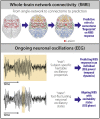Predicting the Response to Non-invasive Brain Stimulation in Stroke
- PMID: 31001190
- PMCID: PMC6454031
- DOI: 10.3389/fneur.2019.00302
Predicting the Response to Non-invasive Brain Stimulation in Stroke
Keywords: EEG; NIBS; fMRI; functional connectivity; long-range temporal correlations; ongoing neuronal oscillations; stroke; variability.
Figures

Similar articles
-
Transorbital alternating current stimulation modifies BOLD activity in healthy subjects and in a stroke patient with hemianopia: A 7 Tesla fMRI feasibility study.Int J Psychophysiol. 2020 Aug;154:80-92. doi: 10.1016/j.ijpsycho.2019.04.002. Epub 2019 Apr 9. Int J Psychophysiol. 2020. PMID: 30978369
-
Reorganization of Brain Functional Connectivity Network and Vision Restoration Following Combined tACS-tDCS Treatment After Occipital Stroke.Front Neurol. 2021 Oct 27;12:729703. doi: 10.3389/fneur.2021.729703. eCollection 2021. Front Neurol. 2021. PMID: 34777199 Free PMC article.
-
Electroencephalogram (EEG) With or Without Transcranial Magnetic Stimulation (TMS) as Biomarkers for Post-stroke Recovery: A Narrative Review.Front Neurol. 2022 Feb 22;13:827866. doi: 10.3389/fneur.2022.827866. eCollection 2022. Front Neurol. 2022. PMID: 35273559 Free PMC article. Review.
-
Things you wanted to know (but might have been afraid to ask) about how and why to explore and modulate brain plasticity with non-invasive neurostimulation technologies.Rev Neurol (Paris). 2022 Oct;178(8):826-844. doi: 10.1016/j.neurol.2021.12.014. Epub 2022 May 24. Rev Neurol (Paris). 2022. PMID: 35623940 Review.
-
Opportunities for concurrent transcranial magnetic stimulation and electroencephalography to characterize cortical activity in stroke.Front Hum Neurosci. 2015 May 5;9:250. doi: 10.3389/fnhum.2015.00250. eCollection 2015. Front Hum Neurosci. 2015. PMID: 25999839 Free PMC article.
Cited by
-
Speed of Processing (SoP) Training Plus α-tACS in People With Mild Cognitive Impairment: A Double Blind, Parallel, Placebo Controlled Trial Study Protocol.Front Aging Neurosci. 2022 Jul 14;14:880510. doi: 10.3389/fnagi.2022.880510. eCollection 2022. Front Aging Neurosci. 2022. PMID: 35928993 Free PMC article.
-
A New Framework to Interpret Individual Inter-Hemispheric Compensatory Communication after Stroke.J Pers Med. 2022 Jan 6;12(1):59. doi: 10.3390/jpm12010059. J Pers Med. 2022. PMID: 35055374 Free PMC article. Review.
-
Efficacy of Cerebellar Transcranial Magnetic Stimulation for Post-stroke Balance and Limb Motor Function Impairments: Meta-analyses of Random Controlled Trials and Resting-State fMRI Studies.Cerebellum. 2024 Aug;23(4):1678-1696. doi: 10.1007/s12311-024-01660-7. Epub 2024 Jan 27. Cerebellum. 2024. PMID: 38280142
-
Frontoparietal Structural Network Disconnections Correlate With Outcome After a Severe Stroke.Hum Brain Mapp. 2024 Nov;45(16):e70060. doi: 10.1002/hbm.70060. Hum Brain Mapp. 2024. PMID: 39487651 Free PMC article.
-
Personalized strategies of neurostimulation: from static biomarkers to dynamic closed-loop assessment of neural function.Front Neurosci. 2024 Mar 7;18:1363128. doi: 10.3389/fnins.2024.1363128. eCollection 2024. Front Neurosci. 2024. PMID: 38516316 Free PMC article. Review.
References
LinkOut - more resources
Full Text Sources

